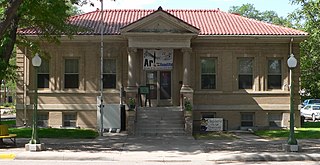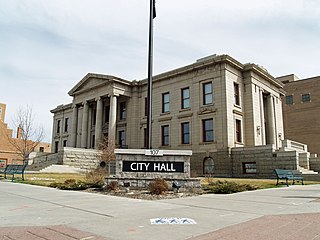
The Gratz Park is a neighborhood and historic district located just north of downtown Lexington, Kentucky. It was named after early Lexington businessman Benjamin Gratz whose home stands on the corner of Mill and New streets at the edge of Gratz Park. The historic district consists of 16 contributing buildings including the Hunt-Morgan House, the Bodley-Bullock House, the original Carnegie library in Lexington, and several other private residences. Gratz Park occupies a tract of land that was established in 1781 outside the original boundaries of Lexington.

The Oregon Public Library is located in Oregon, Illinois, United States, the county seat of Ogle County. The building is a public library that was constructed in 1909. Prior to 1909, Oregon's library was housed in different buildings, none of which were designed to house a library. The library was built using a grant from wealthy philanthropist Andrew Carnegie. The grant was obtained after Oregon's citizens voted to change Oregon's library from a city library to a township library. The building was completed by 1908 but the library did not begin operation until 1909.

The Aitkin Carnegie Library is a Carnegie library in Aitkin, Minnesota, United States. It was designed by architects Claude & Starck and was built in the Classical Revival style. It was listed on the National Register of Historic Places in 1982.

The Central New Bedford Historic District is one of nine historic districts in New Bedford, Massachusetts, United States. The district encompasses the city's central business district, built up during the time in the late 19th century when textiles had replaced whaling as the city's main industry. It is a 29-acre (12 ha) rectangular area bounded by Acushnet Avenue and the older New Bedford Historic District on the east, School Street to the south, Middle Street on the north and 6th Street in the west. It was added to the National Register of Historic Places in 1980.

The West Somerville Branch Library is a historic library at 40 College Avenue in Somerville, Massachusetts, just outside Davis Square. It is a fine local example of Classical Revival architecture, built in 1909 with funding support from Andrew Carnegie, and was the city's first branch library. It was listed on the National Register of Historic Places in 1989.

The Greenwich Avenue Historic District is a historic district representing the commercial and civic historical development of the downtown area of the town of Greenwich, Connecticut. The district was listed on the National Register of Historic Places on August 31, 1989. Included in the district is the Greenwich Municipal Center Historic District, which was listed on the National Register the year before for the classical revival style municipal buildings in the core of Downtown. Most of the commercial buildings in the district fall into three broad styles, reflecting the period in which they were built: Italianate, Georgian Revival, and Commercial style. The district is linear and runs north–south along the entire length of Greenwich Avenue, the main thoroughfare of Downtown Greenwich, between U.S. Route 1 and the New Haven Line railroad tracks.
The Conyers Residential Historic District is an irregularly-shaped historic district in Conyers, Georgia, the only city in Rockdale County, Georgia, located 24 miles east of Atlanta. The district's development dates from the 1840s.

The Carnegie Library in Anaheim, California is a Carnegie library building built in 1908. The Classical Revival style building was designed by John C. Austin, and opened in 1909.

The Hollister Carnegie Library is located on 375 Fifth Street in Hollister, California, US. Established in 1912 as a Carnegie library, decades later, it was re-purposed as a city hall. The building is part of the downtown's National Register-listed historic district, and was entered itself into the National Register on March 26, 1992.

John James Huddart (1856–1930), known usually as John J. Huddart, was a British born and trained architect who practised out of Denver, Colorado in the United States. At the end of the Nineteenth century he was one of Denver's leading architects, known for his work on public buildings and as a courthouse architect. His practice lasted from 1882 to 1930 and commissions included Charles Boettcher House in Denver, Colorado's Fort Morgan State Armory, Denver's Filbeck Building, and six of Colorado's county courthouses.

The Goodland City Library, at 120 W. 12th St. in Goodland, Kansas was built in 1912 and was used as a library for 60 years. It was designed with Italian Renaissance Revival architecture by Denver architects Barrensen Brothers. It was one of 59 Carnegie libraries in Kansas; it was funded initially by a $10,000 Carnegie grant.

The Colorado Springs City Hall is a municipal building in Colorado Springs, Colorado. The building is on the National Register of Historic Places.

The Olney Carnegie Library is a Carnegie library located at 401 E. Main St. in Olney, Illinois. Olney's library association was founded in 1882, but the city did not have its own library building until the Carnegie Library was constructed in 1904. The library was designed in the Classical Revival style by John W. Gaddis; it is the only Classical Revival building in Olney. Its design features brick pilasters with Corinthian capitals, two terra cotta finials atop the roof, and leaded-glass windows with keystone-patterned stone lintels. The library served as Olney's main library until 1990 and is now the Carnegie Museum.

The Carnegie Free Public Library, also known as the Carnegie Town Hall, is a historic Carnegie library located at 235 W. 10th St. in Sioux Falls, South Dakota. The library was built in 1903 through a $25,000 grant from the Carnegie Foundation. Architect Joseph Schwartz designed the building, a Romanesque Revival structure with Neoclassical influences. The library was built from locally quarried quartzite, a popular local building material at the turn of the century. While the building's massive form and rough-hewn stone exterior are Romanesque, it features a Greek pediment above the entrance supported by four pilasters on either side of the doorway. The building represents the only use of Classical details in a quartzite building in Sioux Falls.

The Carnegie Library at Livermore, California, opened in 1911 and continued in use as a library until 1966. It now hosts a historical museum and art gallery. The building was designed by William H. Weeks in the Greek Revival style and is included on the National Register of Historic Places. A weekly farmers' market takes place in the surrounding park.

The Kewanee Public Library is a Carnegie library located at 102 South Tremont Street in Kewanee, Illinois. The library was built in 1907–08 to house the city's public library, which was formed in 1875 and had previously occupied a room in the town hall. The city's first attempt at building a Carnegie library came in 1901, but it could not secure funding to match Carnegie's $20,000 grant; later in the decade, it approved additional community funding and convinced Carnegie to supply an additional $5,000. Chicago architects Patton & Miller, who were well known for their work on Carnegie libraries, designed the Classical Revival building. The library's design includes an entrance flanked by four stone columns and topped by a portico, stone pilasters to either side of the front windows, and a classical entablature with a frieze and dentillated cornice.

The Streator Public Library is a historic Carnegie library located at 130 S. Park Street in Streator, Illinois. Opened in 1903, the library was the first permanent home for Streator's library association. Architects Patton & Miller designed the Classical Revival building. The library is listed on the National Register of Historic Places and is still home to Streator's main public library.

The Coffeyville Carnegie Public Library Building, located at 415 W. Eighth in Coffeyville, Kansas, is a Carnegie library which was built in 1912. It was listed on the National Register of Historic Places in 1987.

The Carnegie Public Library in Rocky Ford, Colorado is a Carnegie library built in 1908. It was listed on the National Register of Historic Places in 1995.

The Longmont Carnegie Library, at 457 Fourth Ave. in Longmont, Colorado, is a Carnegie library which was completed in 1913. It was listed on the National Register of Historic Places in 1992, and was included as a contributing building in the Downtown Longmont Historic District in 2017.




















